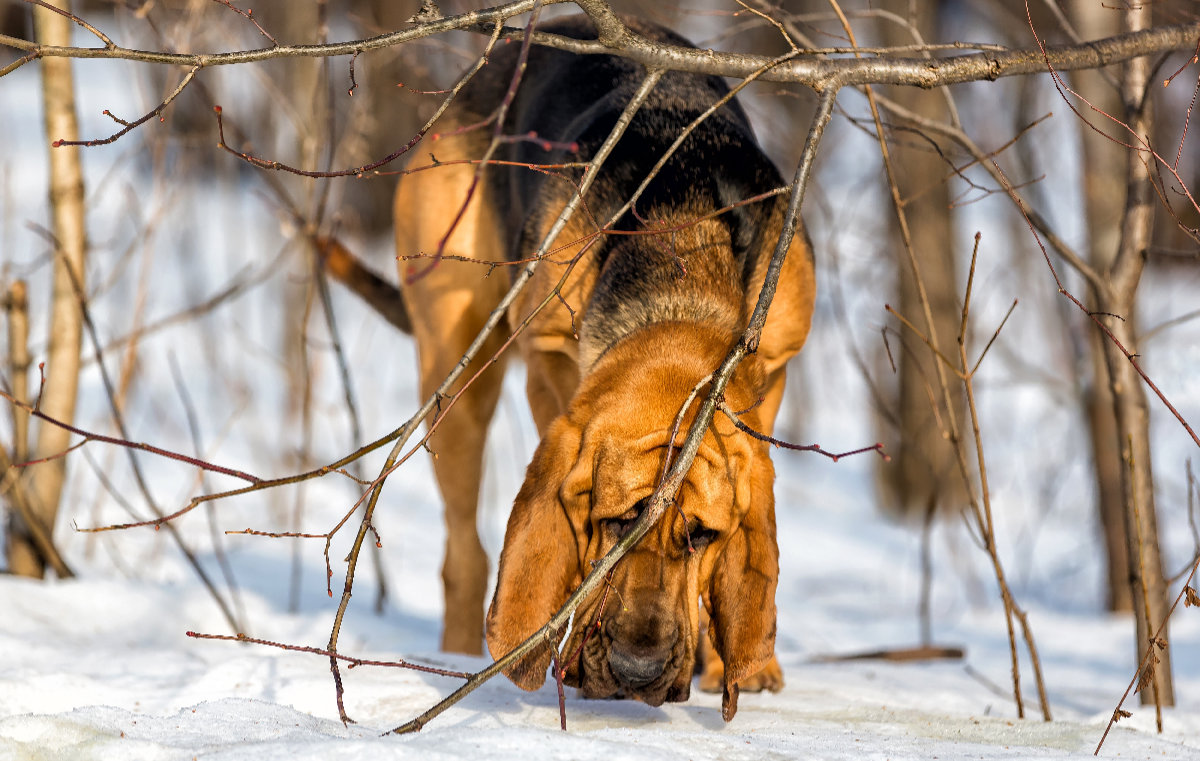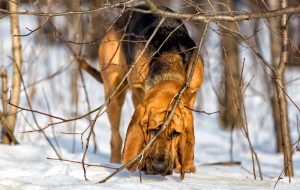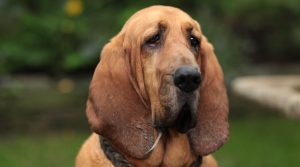
Bloodhound – Hound Dog Breed

Image: Edoma/Shutterstock.com
| Name | Bloodhound - Hound |
|---|---|
| Size | Large |
| Grooming | Moderate |
| Training | Moderate - Difficult |
| Exercise | Daily / 2 hours a day |
| Origins | France |
The Best Scent Hound in Existence
Born To Track You Down!

Image: Degtyaryov Andrey/Shutterstock.com
Quick Overview
Name: The Bloodhound – le chien de sang (en Francais)
Size: Up to 28 inches in height
Weight: Up to 54 kg (a big dog)
Grooming: Minimal although they might cast
Temperament: Gentle for their size, can smell home from miles away
Training: They are stubborn but are great at scent tracking
Exercise: Less than you would think, around 2 hours a day
Life Span: 10-12 years
Origins: Unknown – an ancient breed
Breed Type: Hound
History of the Bloodhound Breed
This cunning doggy has such a good sense of smell that they have been cross-bred time and time again to create hunting and gun dogs, as well as other breeds of hound. The black and tan coonhound, for example, is but one of the many breeds descended from them. It is also known as the St. Hubert Hound since the earliest recorded breeders were monks. Although we don’t officially know where they came from, there is reference to scent hounds of unparalleled success in Roman texts, meaning they might be Italian in origin.
At any rate, around a thousand years ago, a Belgian monastery bred them in packs to protect and hunt on the monastery grounds. The dogs were then picked up by nobility, who cottoned on to the fact that they made fantastic scent hounds. The dogs came to be known as blooded hounds because they were bred by royals, the ‘bloodied’ part meaning that they were ‘of royal blood’. Their abilities to track humans over miles and miles is world-renowned – but it isn’t (as we all thought) anything to do with the smell of our blood.
The Royal Dog
By the time Henry VIII had come to the throne, the bloodhound was truly ingrained into royal culture. After the French Revolution and the Napoleonic Wars, however, this France-focused breed almost died out. It was realised at some point over the years that there were multiple types and factors that contributed to being bloodhounds. Modern genetics have found that the St Hubert strain was long since extinct, but that the modern version of the Bloodhound wouldn’t exist if it weren’t for their DNA.
Nowadays, the Bloodhound breed is known throughout the world. The United Kennel Club set the breed standard first, with America following in 1885 and the UK joining suit. While they were originally black and white, the modern bloodhound tends to be a tan or black colour. Bloodhounds are strong, muscular dogs that can run for miles when on the trail. They are used globally by police forces who need to track down the occasional escaped convict, or the occasional missing person. Best of all though they are the workhorse of dog breeds, able to run for hours or not at all. This is a dog breed that has existed since before the crusades, before the Roman invasion of Britain, and before the French Revolution. If breed standards could talk, this one would speak for years. They are still used as hunting dogs and as gun dogs, to this very day.
A Few Facts about the Bloodhound Breed!
Here at Five Minutes Spare we take great doggy delight in preserving the funniest and most interesting things about your new bloodhound puppy. Without further ado, here they are:
- There have been references to the bloodhound in Britain since the 12th It is equally likely that they were brought here by the Romans during the invasion around 40 AD.
- William the Conqueror loved these dogs and it is speculated that he would have brought some with him, therefore sparking renewed interest in the breed.
- The bloodhound can trace an individual scent for miles upon miles – but during the hunt, it will not attack. It will alert, yes, but it is far too gentle an animal to attack prey.
- They were once used to keep the Scottish out of England by hunting Scotsmen on the borders! Eek!
- The scientist Robert Boyle once experimented with these hounds and found that one of them tracked a single man over ten miles of publicly used walkway, to find him upstairs in a house.
So if you are the proud owner of a bloodhound puppy, hiding treats around the house for him to find will train him to scent seek, while simultaneously keeping him occupied. Prepare to be amazed at that sense of smell.
Do They Need Much Grooming?
Absolutely not… take it out back once a year and toss some hot soapy water over it. Your bloodhound is likely to shed twice a year and is not hypo-allergenic. You can be sure that it will need its teeth brushed every few weeks too. It may or may not need its claws trimmed, that is up to you.
How Often Do I Exercise My Bloodhound?
They get away with two long walks a day but do best with a yard to wander in. They take surprisingly little exercise considering their large size. If you can, play with them often and take them to work with you. Remember you will have to keep them on a dog lead because of the high prey drive and instinct to chase.
Are They Hard to Train?
They are stubborn dogs that can’t really be bothered with your nonsense. They won’t make the ideal breed if you want to do dog agility. Socialise them young by taking them to obedience classes to get the best from bonding with your bloodhound.

Even their expressions say Stubborn
Image: Huckleberry14/Shutterstock.com
Where Can I Buy a Bloodhound Puppy?
You should approach the dog shelters in your area and reserve any bloodhound pups that come through their doors. Alternatively, buy from a breeder who is registered through your local kennel club as this prevents the risk of buying from a puppy farmer. If your breeder cannot present you with paperwork or won’t let you meet your dog’s parents, you are in danger of using a puppy farm.
Are they a Healthy Breed?
Watch out for knee or elbow dysplasia. An x-ray around one year old will reveal this. Patellar luxation (floating kneecap) is also possible. Always take out pet insurance to make sure you have the finances you need if something goes wrong.
Not The Doggo For You?
If you are determined to find the puppy that most suits your personality type, we advise that you head over to Five Minutes Spare HQ and check out our doggo directory. We have everything you need to know about most breeds… and we add more every day. It’s always worth checking in to see what you might have missed.